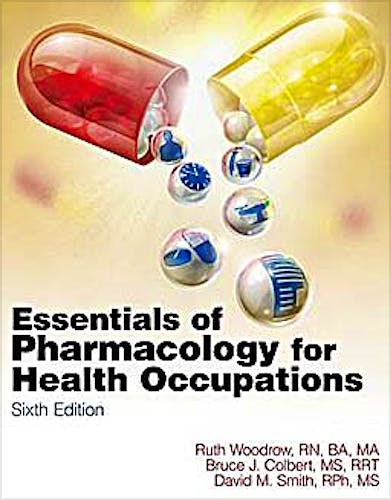

No hay productos en el carrito



Essentials of Pharmacology for Health Occupations
Woodrow, R. — Colbert, B. — Smith, D.
6ª Edición Julio 2010
Inglés
Tapa blanda
656 pags
1500 gr
19 x 25 x 2 cm
ISBN 9781435480339
Editorial DELMAR
LIBRO IMPRESO
-5%
50,15 €47,64 €IVA incluido
48,22 €45,81 €IVA no incluido
Recíbelo en un plazo de
2 - 3 semanas
Description
Essentials of Pharmacology for Health Occupations, 6th Edition provides an extensive framework of drug information in a concise format for learners studying licensed practical nursing, medical assisting and other allied health professions. Learn calculations quickly through a simplified step-by-step process. Discover key drug information by classifications, such as their purpose, side effects, cautions, and interactions, or utilize this resource to refresh your knowledge of drugs. The accompanying CD-ROM helps learners master pharmacology through quizzes, games, and case studies with immediate feedback and medication administration techniques and safety video clips. Open this resource now and see how easy learning pharmacology can be.
New to this Edition
- NEW Studyware Connection directs learner to additional learning opportunities such as quizzes, case studies, medication administration techniques and safety videos, drug label exercises, and other interactive games included on the accompanying Studyware CD-ROM
- NEW quizzes with NCLEX-style questions and an audio library of generic and trade name drugs and general pharmacology terms are featured on the accompanying Studyware CD-ROM
- The most common and/or most important side effects of drugs are highlighted with a special icon that serves as a valuable guide for learners.
- Patient Education is summarized and highlighted for each classification of drugs. These special boxes will assist health care workers to instruct patients on and answer questions about the medications they are taking.
- Case Studies stimulate critical thinking through the presentation of reality-based situations regarding drug usage.
Table of Contents
PART 1: INTRODUCTION
1. Consumer Safety and Drug Regulations.
Drug Laws. FDA and DEA. Health Care Workers and the Law.
2. Drug Names and References.
Classifications. Identifying Names. Legal Terms Referring to Drugs. Terms Indicating
Drug Actions. Drug References. The Internet as Reference. Drug Cards.
3. Sources and Bodily Effects of Drugs.
Sources of Drugs. Effects of Drugs. Drug Processing by the Body (Pharmacokinetics).
Absorption. Distribution. Metabolism. Excretion. Other Variables. Unexpected
Responses to Drugs.
4. Medication Preparations and Supplies.
A Space-Age Drug Form. Standard Drug Forms. Supplies.
5. Abbreviations and Systems of Measurement.
Abbreviations. Systems of Measurement.
6. Safe Dosage Preparation.
Basic Arithmetic Test. Calculation Guidelines. Method 1: Basic Calculation.
Method 2: Ratio and Proportion. Pediatric Dosage. Geriatric Dosage. Prevention
of Medication Errors.
7. Responsibilities and Principles of Drug Administration.
Responsible Drug Administration. Medication Errors. Principles of Administration.
8. Administration by the Gastrointestinal Route.
Administration of Medications Orally. Administration of Medications by Nasogastric
Tube. Administration of Medications by Gastric Tube. Administration of Medications
Rectally.
9. Administration by the Parenteral Route.
Sublingual and Buccal Administration. Transcutaneous Drug Delivery System. Inhalation
Therapy. Injections. Skin Medications. Application to the Mucous Membranes.
Eye Medications.
10. Poison Control.
Poisoning by Ingestion. Poisoning by Inhalation. External Poisoning of Skin
or Eyes. Poisoning by Sting and Snakebite. People at Risk.
PART II: DRUG CLASSIFICATIONS.
11. Vitamins, Minerals, and Herbs.
Fat-Soluble Vitamins. Water-Soluble Vitamins. Minerals. Antioxidants. Alternative
Medicines. References. Online References.
12. Skin Medications.
Antipruritics. Corticosteroids. Emollients and Demulcents. Keratolytics. Scabicides
and Pediculicides. Antifungals. Antivirals. Local Anti-Infectives. Agents Used
to Treat Acne. Cautions for Topical Medications.
13. Autonomic Nervous System Drugs.
Adrenergics. Adrenergic Blockers. Cholinergics. Cholinergic Blockers.
14. Antineoplastic Drugs.
Antimetabolites. Alkylating Agents. Plant Alkaloids. Antibiotic Antineoplastics.
Hormone Therapy. Biological Response Modifiers. Monoclonal Antibodies. Radioactive
Isotopes. Cautions and Responsibilities for Antineoplastic Drugs.
15. Urinary System Drugs.
Diuretics. Medications for Gout. Antispasmodics. Cholinergics. Analgesics. Treatment
of Benign Prostatic Hypertrophy (BPH). Alpha-Blockers.
16. Gastrointestinal Drugs.
Antacids. Agents for Treatment of Ulcers and Gastroesophageal Reflux Disease.
Antispasmodics/Anticholinergics. For Inflammatory Bowel Disease. Antidiarrhea
Agents. Antiflatulents. Laxatives and Cathartics. Antiemetics. Prophylaxis.
17. Anti-infective Drugs.
Vaccines. Aminoglycosides. Cephalosporins. Macrolides. Penicillins. Quinolones.
Tetracyclines. Antifungals. Antituberculosis Agents. Miscellaneous Anti-Infectives.
Agents for VRE. Antivirals. Treatment of Human Immunodeficiency Virus/AIDS Infections.
HIV Information and Resources. Sulfonamides. Urinary Anti-Infectives.
18. Eye Medications.
Anti-Infectives. Anti-Inflammatory Agents. Antiglaucoma Agents. Mydriatics.
Local Anesthetics.
19. Analgesics, Sedatives, and Hypnotics.
Analgesics. Local Anesthetic. Antimigraine Agents. Sedatives and Hypnotics.
20. Psychotropic Medications, Alcohol, and Drug Abuse .
CNS Stimulants. Selective Norepinephrine Reuptake Inhibitor (SNRI). Antidepressants.
Antimanic Agents. Anxiolytics. Antipsychotic Medications/Major Tranquilizers.
Alcohol. Drug Abuse.
21. Musculoskeletal and Anti-inflammatory Drugs.
Skeletal Muscle Relaxants. Anti-Inflammatory Drugs. Osteoporosis Therapy.
22. Anticonvulsants, Antiparkinsonian Drugs,and Agents for Alzheimer's Disease.
Anticonvulsants. Drugs for Absence Epilepsy. Drugs for Grand Mal and Psychomotor
Epilepsy. Antiparkinsonian Drugs. Agents for Alzheimer's Disease.
23. Endocrine System Drugs.
Pituitary Hormones. Adrenal Corticosteroids. Thyroid Agents. Antithyroid Agents.
Antidiabetic Agents.
24. Reproductive System Drugs.
Androgens. Impotence Agents. Estrogens. Progestins. Choice of Contraceptives.
Drugs for Labor and Delivery. Other Gonadotropic Drugs. Infertility Drugs.
25. Cardiovascular Drugs.
Cardiac Glycosides. Antiarrhythmic Agents. Antihypertensives. Other Antihypertensives.
Coronary Vasodilators. Antilipemic Agents. Vasoconstrictors. Anticoagulants.
Platelet Inhibitor Therapy. Thrombolytic Agents. Colony Stimulating Factors
(CSFs).
26. Respiratory System Drugs and Antihistamines.
Oxygen. Respiratory Stimulants. Bronchodilators. Corticosteroids. Asthma Prophylaxis.
Mucolytics and Expectorants. Antitussives. Antihistamines. Decongestants. Smoking
Cessation Aids.
27. Drugs and Older Adults.
Cumulative Effects of Drugs. Potentially Inappropriate Medication Use in Older
Adults. Drugs That May Cause Mental Impairment. Nonsteroidal Anti-inflammatory
Drugs. Polypharmacy.
References.
Summary.
Comprehensive Review Exam for Part I.
Comprehensive Review Exam for Part II.
Appendix: Use Caution—Avoid Confusion
About the Author
Ruth Woodrow, RN, MA Medical Consultant for Education and
Infection Control Senior Friendship Centers Inc., Health Services Sarasota,
FL Former Director, Staff Development Plymouth Harbor, Inc. Sarasota, FL Former
Instructor, Pharmacology Coordinator, Continuing Education Sarasota County Technical
Institute Sarasota, FL
Bruce J. Colbert, M.S., RR is the Director of the Respiratory Care
Program at the University of Pennsylvania at Johnston.
© 2026 Axón Librería S.L.
2.149.0